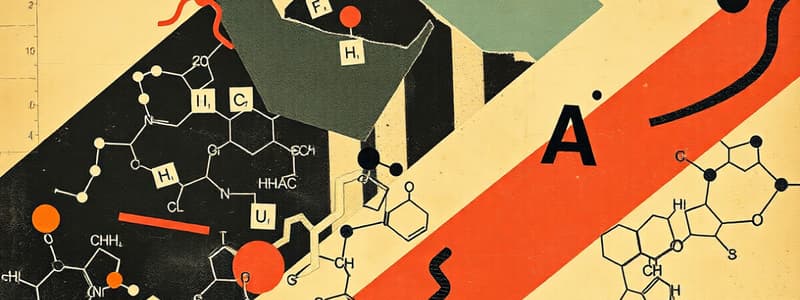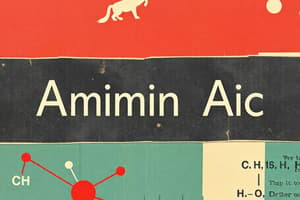Podcast
Questions and Answers
What is the primary role of amino acids in the body?
What is the primary role of amino acids in the body?
- They are the main source of vitamins.
- They function solely as enzymes.
- They act as energy sources.
- They are the building blocks of proteins. (correct)
Which part of an amino acid structure is characteristic and varies among different amino acids?
Which part of an amino acid structure is characteristic and varies among different amino acids?
- Carbon backbone
- NH2 group
- COOH group
- Side Chain (R) (correct)
What reaction process is involved in obtaining amino acids from proteins?
What reaction process is involved in obtaining amino acids from proteins?
- Oxidation
- Transamination
- Hydrolysis (correct)
- Condensation
How many standard amino acids are there in proteins?
How many standard amino acids are there in proteins?
Which of the following classifications is NOT used for amino acids?
Which of the following classifications is NOT used for amino acids?
What groups are present in the general structure of each alpha-amino acid?
What groups are present in the general structure of each alpha-amino acid?
Which enzyme is involved in the hydrolysis of proteins in the stomach to release amino acids?
Which enzyme is involved in the hydrolysis of proteins in the stomach to release amino acids?
The side chain (R) group of an amino acid can vary, influencing its properties. What does this variability primarily affect?
The side chain (R) group of an amino acid can vary, influencing its properties. What does this variability primarily affect?
Which group of amino acids is classified as neutral based on their chemical structure?
Which group of amino acids is classified as neutral based on their chemical structure?
What distinguishes acidic amino acids from neutral amino acids in terms of their chemical groups?
What distinguishes acidic amino acids from neutral amino acids in terms of their chemical groups?
Which of the following amino acids is considered basic?
Which of the following amino acids is considered basic?
Which amino acid classification involves amino acids that predominantly carry a positive charge?
Which amino acid classification involves amino acids that predominantly carry a positive charge?
How many carboxylic acid groups are present in acidic amino acids?
How many carboxylic acid groups are present in acidic amino acids?
Which of the following statements about neutral amino acids is correct?
Which of the following statements about neutral amino acids is correct?
Which amino acids fall under the category of hydrophobic amino acids?
Which amino acids fall under the category of hydrophobic amino acids?
What is the primary feature of basic amino acids regarding their amino and carboxylic groups?
What is the primary feature of basic amino acids regarding their amino and carboxylic groups?
Which statement accurately describes the chemical classification of amino acids?
Which statement accurately describes the chemical classification of amino acids?
Which of the following aliphatic amino acids does not contain a side chain?
Which of the following aliphatic amino acids does not contain a side chain?
Which amino acid is correctly classified as a sulfur-containing amino acid?
Which amino acid is correctly classified as a sulfur-containing amino acid?
Among the listed amino acids, which one contains both a $COOH$ and an $NH_2$ group in its structure?
Among the listed amino acids, which one contains both a $COOH$ and an $NH_2$ group in its structure?
What characterizes branched-chain amino acids (BCAAs)?
What characterizes branched-chain amino acids (BCAAs)?
Which of the following amino acids contains a hydroxy group ($-OH$) in its structure?
Which of the following amino acids contains a hydroxy group ($-OH$) in its structure?
Which amino acid is classified as basic due to the presence of an additional amino group?
Which amino acid is classified as basic due to the presence of an additional amino group?
Which amino acid has the structure with the formula of $C_3H_7NO_2$?
Which amino acid has the structure with the formula of $C_3H_7NO_2$?
What is the primary functional group present in all amino acids?
What is the primary functional group present in all amino acids?
Which amino acid is classified as an acidic amino acid due to the presence of an extra carboxyl group?
Which amino acid is classified as an acidic amino acid due to the presence of an extra carboxyl group?
Which of the following amino acids can be described as both aliphatic and aromatic?
Which of the following amino acids can be described as both aliphatic and aromatic?
Which of the following amino acids is classified as semi-essential?
Which of the following amino acids is classified as semi-essential?
Which group of amino acids includes only essential amino acids?
Which group of amino acids includes only essential amino acids?
Which amino acid is not classified as essential?
Which amino acid is not classified as essential?
Which amino acid is part of the 'VIP' category?
Which amino acid is part of the 'VIP' category?
Which amino acid is classified as an imino acid?
Which amino acid is classified as an imino acid?
Which amino acids do not contain a benzene group?
Which amino acids do not contain a benzene group?
Which amino acids are found in the 'Mall' group?
Which amino acids are found in the 'Mall' group?
Which of these amino acids is considered non-essential?
Which of these amino acids is considered non-essential?
What is true about essential amino acids?
What is true about essential amino acids?
What is the primary reason arginine and histidine are classified as semi-essential?
What is the primary reason arginine and histidine are classified as semi-essential?
Which of the following amino acids contains an SH group?
Which of the following amino acids contains an SH group?
Which amino acid is classified as non-essential?
Which amino acid is classified as non-essential?
Which of the following pairs contains aromatic amino acids?
Which of the following pairs contains aromatic amino acids?
Which amino acid is usually found in higher concentrations in meat?
Which amino acid is usually found in higher concentrations in meat?
What characteristic is shared by tryptophan and phenylalanine?
What characteristic is shared by tryptophan and phenylalanine?
Which group does histidine belong to based on nutritional classification?
Which group does histidine belong to based on nutritional classification?
Which statement about cysteine and cystine is true?
Which statement about cysteine and cystine is true?
Flashcards
Amino Acid Classification
Amino Acid Classification
Amino acids are categorized based on the relative number of amino and carboxylic acid groups.
Neutral Amino Acids
Neutral Amino Acids
Amino acids with an equal number of amino and carboxylic acid groups, carrying no net charge.
Acidic Amino Acids
Acidic Amino Acids
Amino acids with more carboxylic acid groups than amino groups, carrying a net negative charge.
Basic Amino Acids
Basic Amino Acids
Signup and view all the flashcards
Glycine
Glycine
Signup and view all the flashcards
Alanine
Alanine
Signup and view all the flashcards
Aspartic Acid
Aspartic Acid
Signup and view all the flashcards
Glutamic Acid
Glutamic Acid
Signup and view all the flashcards
Arginine
Arginine
Signup and view all the flashcards
Lysine
Lysine
Signup and view all the flashcards
Amino acid definition
Amino acid definition
Signup and view all the flashcards
Amino acid structure
Amino acid structure
Signup and view all the flashcards
Amino acid classification types
Amino acid classification types
Signup and view all the flashcards
How to obtain amino acids
How to obtain amino acids
Signup and view all the flashcards
Number of known amino acids
Number of known amino acids
Signup and view all the flashcards
What is the carboxyl group
What is the carboxyl group
Signup and view all the flashcards
What is the amino group
What is the amino group
Signup and view all the flashcards
Side Chain (R) role
Side Chain (R) role
Signup and view all the flashcards
Aliphatic AAs
Aliphatic AAs
Signup and view all the flashcards
Branched-chain AAs
Branched-chain AAs
Signup and view all the flashcards
Hydroxyl AAs
Hydroxyl AAs
Signup and view all the flashcards
Sulfur-containing AAs
Sulfur-containing AAs
Signup and view all the flashcards
Isoleucine
Isoleucine
Signup and view all the flashcards
Amino Acid Components
Amino Acid Components
Signup and view all the flashcards
Essential amino acids
Essential amino acids
Signup and view all the flashcards
Non-essential amino acids
Non-essential amino acids
Signup and view all the flashcards
Methionine
Methionine
Signup and view all the flashcards
Phenylalanine
Phenylalanine
Signup and view all the flashcards
Tryptophan
Tryptophan
Signup and view all the flashcards
Proline
Proline
Signup and view all the flashcards
Semi-Essential Amino Acids
Semi-Essential Amino Acids
Signup and view all the flashcards
Histidine
Histidine
Signup and view all the flashcards
Leucine, Isoleucine
Leucine, Isoleucine
Signup and view all the flashcards
Study Notes
Amino Acid Classifications
- Amino acids are the structural units of proteins.
- They are obtained from protein via acid, alkali, or enzymatic hydrolysis.
- There are 20 known amino acids (21 after adding selenocysteine).
General Structure of Amino Acids
- Each α-amino acid has a carboxyl group (COOH), an amino group (NH2), and a side chain (R group).
- The R group differentiates amino acids, influencing their chemical and biological properties.
Classification of Amino Acids
-
1. Chemical Classification: Based on the number of amino and carboxyl groups in the side chain.
- Neutral Amino Acids: Have one amino and one carboxyl group. Examples: Glycine, Alanine, Serine, Threonine, Cysteine, Cystine, Valine, Leucine, Isoleucine, Phenylalanine, Tyrosine, Tryptophan.
- Acidic Amino Acids: Have more than one carboxyl group and one amino group; they carry a negative charge. Examples: Aspartic acid, Glutamic acid.
- Basic Amino Acids: Have more than one amino group and one carboxyl group; they carry a positive charge. Examples: Arginine, Histidine, Lysine.
-
2. Nutritional Classification: Based on whether the body can synthesize the amino acid.
- Essential Amino Acids: The body cannot synthesize these, so they must be obtained from diet. Examples: Valine, Leucine, Isoleucine, Tryptophan, Threonine, Methionine, Phenylalanine, Histidine, Lysine.
- Non-Essential Amino Acids: The body can synthesize these. Examples: Glycine, Alanine, Serine, Tyrosine, Cysteine, Aspartic acid, Glutamic acid, Proline. Some amino acids are considered semi-essential (e.g., arginine and histidine) as the body can produce them, but in insufficient amounts for specific developmental stages.
-
3. Metabolic Classification: Based on the metabolic fate of the amino acid.
- Ketogenic Amino Acids: Broken down into ketone bodies. Examples: Leucine, Lysine.
- Glucogenic Amino Acids: Broken down into glucose. Examples: Alanine, Serine, Glycine, Cysteine, Aspartic acid, Glutamic acid, Proline.
- Mixed Glucogenic and Ketogenic Amino Acids: Can be broken down into both glucose and ketone bodies. Examples: Phenylalanine, Isoleucine, Tryptophan, Threonine, Tyrosine.
Studying That Suits You
Use AI to generate personalized quizzes and flashcards to suit your learning preferences.
Related Documents
Description
This quiz explores the classifications and structures of amino acids, the building blocks of proteins. Learn about their general structure, how they differ chemically, and their classification into neutral, acidic, and basic types. Understanding these concepts is essential for studying biochemistry.




